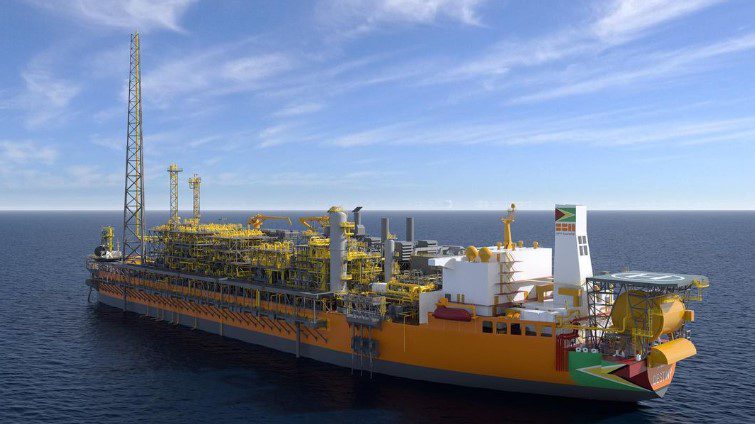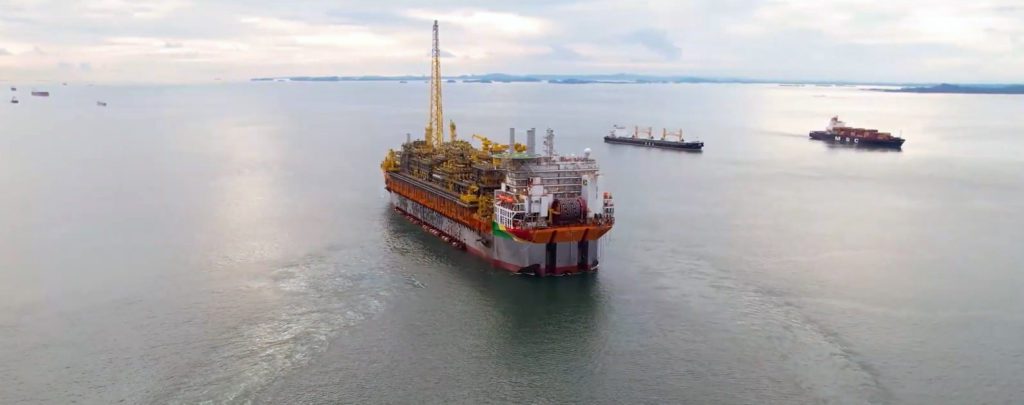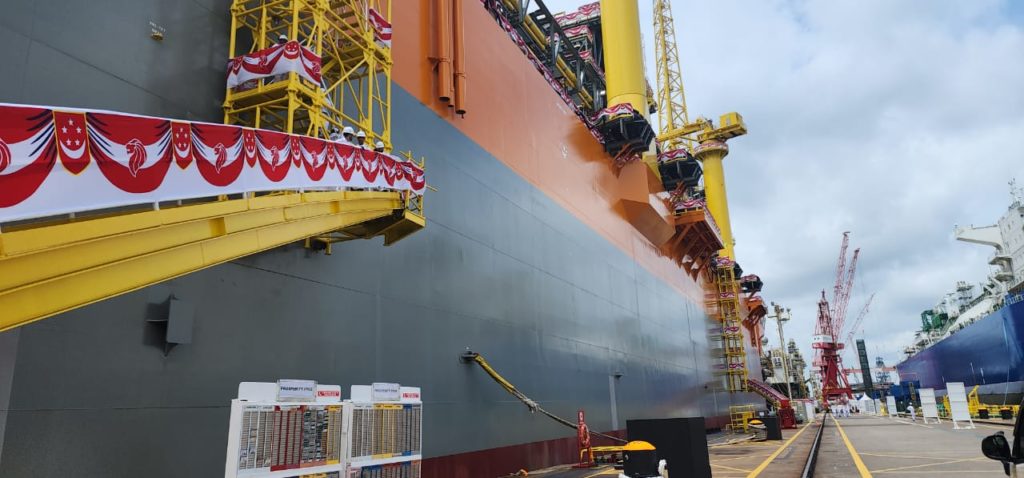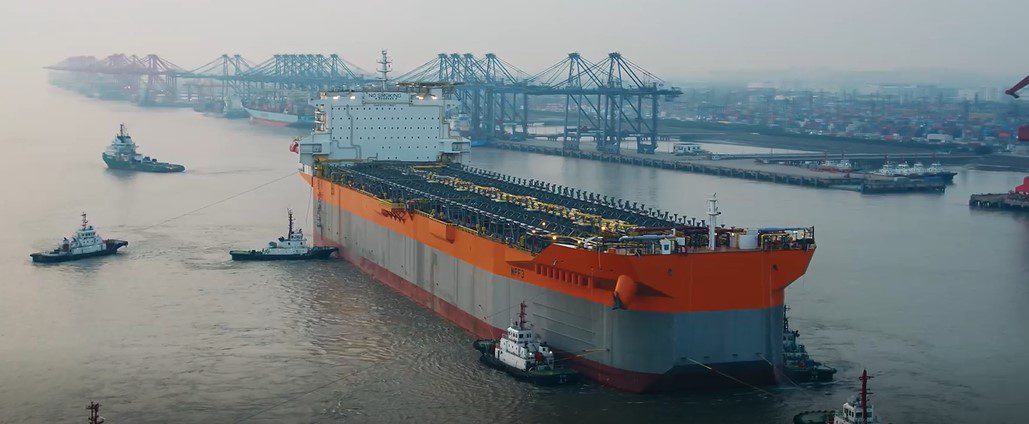By Cristina Caus – OilNOW
On April 11, 2023, the floating production, storage and offloading vessel (FPSO) Prosperity arrived in Guyana and joined the other two FPSOs, Liza Destiny and Liza Unity. This became the third FPSO vessel that has been built and started operations in Guyana’s waters in 2019.
A total of 56 FPSO projects, between 2022 and 2027, are expected to commence their operations worldwide. Brazil leads the list with 22 of them, followed by none other than Guyana, with 3 delivered additions and one in progress. As a new player in the global oil and gas arena, the news about welcoming its third FPSO in 4 years is worth the fanfare for this small Caribbean nation.

According to ExxonMobil, the major operator in Guyana and SBM Offshore, the Dutch group of companies awarded to construct, install and deploy the FPSOs; to date, each project had a cost of approximately US$1 billion (Liza Destiny), US$1.2 billion (Liza Unity), US$1.6 billion (Prosperity) and with the fourth US$1.75 billion contract (One Guyana) on the way. Exxon’s fifth proposed development at the Uaru oilfield, called Errea Wittu will cost approximately 27% more than the Yellowtail project. ExxonMobil and its partners will provide this upfront investment at their own risk and can recoup a percentage of these costs from annual production once it begins.
Some question the rationale behind these rapid developments in oil and gas when the world is moving towards cleaner energy projects. Due to the increasing oil and gas prices in parallel with rising global energy demand, the FPSO market is stimulated to grow by 12.3% between 2022 to 2028, and it looks like it might represent the future of oil and gas. The growth is triggered by the declining rate of new onshore oil discoveries and the rising investments in offshore drilling, with the FPSOs being the most cost-efficient, quicker, mobile, and environmentally-friendly solution compared to the traditional rigs (like fixed platforms).

So, what does all this mean in terms of production for Guyana?
Between 2020 and 2021, Guyana produced around 102,000 barrels per day (bpd) of crude with its first FPSO, the Liza Destiny, and tripled it to 380,000 bpd with its second FPSO, the Liza Unity. Guyana is expecting to reach 600,000 bpd by 2024 with the Prosperity FPSO. This puts Guyana in the top 30 oil producers ranking globally. Exxon is targeting to have six FPSOs in Guyana by the end of 2027 and sees a potential for up to 10 of them to develop its current recoverable resource balance, bringing production capacity to more than 1.2 million bpd. By 2035, the country will be pumping about 1.7 million bpd, based on Rystad Energy research, and might become the 4th largest offshore producer in the world. This would be an unprecedented scenario, bringing Guyana into the same ring with oil giants such as Saudi Arabia, Brazil, the United States, Norway and Mexico.
What would this translate to in terms of revenue for the Guyanese economy?
According to the Central Bank, Guyana closed out 2022 with US$1.27 billion in revenue from oil sales and royalties, which represents almost equivalent to half of the country’s 2022 budget. For the first quarter of 2023, Guyana received US$219 million from oil sales. Guyana is expected to spend US$1 billion of oil revenues, almost 30% of the proposed national budget (US$3.75 billion), Guyana’s largest ever, in the fiscal year 2023. Therefore, the linkage between the FPSOs in Guyana and the economic growth becomes very strong. These investments are skyrocketing the nation’s GDP from US$5.174 billion in 2019 to US$8.92 billion in 2022 and are expected to hit US$11.6 billion by 2025 and have the potential to impact other sectors of the economy. It’s like Monopoly boardgame, more assets you acquire, the faster you establish wealth and the greater are the chances of winning.

As of today, the government has allocated almost US$400 million for health sector advancement for 2023. One of the major projects is the new healthcare center with at least 300 jobs that will be established in Guyana this year, a partnership signed between The Guyana Office for Investment and India’s Decipher Health Records Inc. Several hinterland communities will experience a significant boost in healthcare delivery through an investment of about US$97 million with hospitals upgrades, procurement of ambulances and healthcare professionals training. Also, some of the hinterland regions will benefit from approximately US$50 million worth of investments in infrastructure—including projects like construction of roads, rehabilitation of airstrips, completion of water wells, provision of residential solar systems, and upgrade of electricity distribution networks. Education has a budget allocated of around US$445 million this year to enhance the quality of education in several areas such as Hosororo, Patentia, Orealla, Prospect, Good Hope, Yarrowkabra, North Ruimveldt and Diamond. It includes upgrading education infrastructure around the country, continuing to roll out the National School Feeding Program and introducing the involvement of communities to provide homegrown food products for the schools. The Ministry of Education plans to implement the Education Management Information System Software and create smart classrooms for secondary education.

The benefits can be numerous and incredible for the Guyanese economy if the investments such as those described above are continuously and consistently made to improve certain areas of life and healthcare, education and infrastructure are prioritised. With the fastest-growing GDP in the world, Guyana is given the power to reverse decades of economic stagnation and its people are given the opportunity to access increasing resources by producing more goods and services, achieving higher wages and profits and raising their living standards. As a result, these massive and expensive FPSO investments are a testament to the long-term commitment and partnership between the oil and gas industry and the Guyanese nation, directing the country into a new era of oil and gas exploration and production and economic prosperity.
About the Author

Cristina Caus is an international oil and gas business developer and consultant and holds a master’s degree in international business from Florida International University.




